Best Network Monitoring Software
Best network monitoring software includes ManageEngine OpManager, Site24x7, Atera, LogicMonitor, and NetFlow Analyzer. This software automates network monitoring functions and workflow.



No Cost Personal Advisor
List of 20 Best Network Monitoring Software
The IT monitoring platform
Checkmk – Scalable, automated, and extensible monitoring for dynamic hybrid IT environments. With over 2,000 vendor-maintained plugins, Checkmk delivers comprehensive insights, providing you with a holistic view of your IT landscape like never before. Learn more about Checkmk
Explore various Checkmk features, compare the pricing plans, and unlock the potential of seamless operations by selecting the right software for your business.
Features
View all Checkmk Features- Capacity planning and optimization
- Dashboards and visualization
- Uptime Monitoring
- Two-factor authentication (2FA)
- Multi-User
- Database space usage monitoring
- Device Monitoring
- Network Monitoring
Pricing
Checkmk Caters to
- StartUps
- SMBs
- Agencies
- Enterprises
Category Champions | 2024
Full stack monitoring from the cloud
Site24x7 is one of the most preferred network monitoring tools for SMEs and enterprises alike. Its features include Website Monitoring, Server Monitoring, Application Monitoring, Log Management, Real User Monitoring, Applications Management, etc. It is a pocket-friendly tool that allows monitoring from 120+ locations. It also offers language support in 15 languages. Read Site24x7 Reviews
Explore various Site24x7 features, compare the pricing plans, and unlock the potential of seamless operations by selecting the right software for your business.
Features
View all Site24x7 Features- Email Monitoring
- Mail Server Monitoring
- Virtual Machine Monitoring
- Transaction Monitoring
- Event-Based Notifications
- Root-Cause Diagnosis
- Alerts Notifications
- Trace individual transactions
Pricing
Site24x7 Caters to
- StartUps
- SMBs
- Agencies
- Enterprises
Contenders | 2024
All-in-one IT Operations Management
More than just network monitoring software, ManageEngine is a complete IT Operations management system. It also offers Firewall and IP Address Management, Storage Monitoring, and Bandwidth Analysis. It has features such as Performance Management, AI / Machine Learning, File Integrity Monitoring, Network Logs, Network Diagnosis, Device Auto Discovery, etc. Read ManageEngine OpManager MSP Reviews
Explore various ManageEngine OpManager MSP features, compare the pricing plans, and unlock the potential of seamless operations by selecting the right software for your business.
- Server Monitoring
- Bandwidth Troubleshooting
- Performance Management
- Network Diagnosis
- Network Logs
- Device Auto Discovery
- Virtual Machine Monitoring
- Bandwidth Monitoring
Pricing
ManageEngine OpManager MSP Caters to
- StartUps
- SMBs
- Agencies
- Enterprises
Emergents | 2024
REST APIs returning XML or JSON ability
Paessler PRTG is one of the powerful network monitoring tools that help businesses optimize their IT infrastructure. It monitors websites, systems, traffic, usage, servers, devices, etc. monitor websites, systems, traffic, usage, servers, devices, etc., through exciting features. These features are Network Scanning, Configuration Management, Server Performance, Uptime Monitoring, Automatic Network Discovery, Performance Control, etc. Read PRTG Reviews
Explore various PRTG features, compare the pricing plans, and unlock the potential of seamless operations by selecting the right software for your business.
Features
View all PRTG Features- Email Monitoring
- Server Performance
- Bandwidth Troubleshooting
- Performance Metrics
- Network Scanning
- Maintenance Scheduling
- IP Address Monitoring
- Uptime Monitoring
PRTG Caters to
- StartUps
- SMBs
- Agencies
- Enterprises
Contenders | 2024
Network monitoring software for in-house IT pros
SolarWinds is one of the network monitoring solutions that also provides Database, Systems, Security, Application, and IT Service Management solutions. It comes with a hybrid deployment mode and a unique, one-time payment plan. Features like User Activity Monitoring, CPU Monitoring, Alerts Notifications, Uptime Monitoring, etc., make it a helpful tool. Read SolarWinds Reviews
Explore various SolarWinds features, compare the pricing plans, and unlock the potential of seamless operations by selecting the right software for your business.
Features
View all SolarWinds Features- Backup Log
- Database Servers
- CPU Monitoring
- Scheduling
- Multi-User
- Analytics
- Real Time Monitoring
- Uptime Monitoring
Pricing
Starter
$ 2995
Onetime
SolarWinds Caters to
- StartUps
- SMBs
- Agencies
- Enterprises
Contenders | 2024
Software by Auvik
Auvik is one of the best network monitoring tools that work mainly for Macintosh platforms. Its features include Requisition Management, Audit Management, Root Cause Diagnosis, Service Reporting, Internet Usage Monitoring, Server Monitoring, etc. It also provides Online Asset Management via individual transactions and software inventory and works as an MSP Billing Software. Read Auvik Reviews
Explore various Auvik features, compare the pricing plans, and unlock the potential of seamless operations by selecting the right software for your business.
Features
View all Auvik Features- Diagnostic Tools
- Remote Access
- Bandwidth Monitoring
- Web Traffic Reporting
- Baseline Manager
- Full Transaction Diagnostics
- Backup Management
- Service Reporting
Auvik Caters to
- StartUps
- SMBs
- Agencies
- Enterprises
Contenders | 2024
Network monitoring software for app developers
One of the top network monitoring tools for Windows and Mac alike, Datadog is an excellent software for cloud-scale monitoring for businesses. Its basic plan is free, so even freelancers can use it conveniently. It has many helpful features, such as Event Logs, Performance Metrics, FTP Monitoring, Report Export, Real-time Monitoring, Customizable Dashboard, etc. Read Datadog Reviews
Explore various Datadog features, compare the pricing plans, and unlock the potential of seamless operations by selecting the right software for your business.
Features
View all Datadog Features- Uptime Reporting
- Event Logs
- Customizable Dashboard
- Drill Down
- Drag & Drop
- Event-Based Notifications
- Real Time Monitoring
- Performance Metrics
Pricing
Free
$ 0
Up to 5 Hosts
Pro
$ 15
Per Host/ Month
Datadog Caters to
- StartUps
- SMBs
- Agencies
- Enterprises
Contenders | 2024
All-in-One IT Management Software
Atera has features like Network Diagnosis, IT Budgeting, Patch Management, Network Resource Management, Ticket Management, etc. It is one of the top network monitoring tools for Managed Service Providers (MSPs) and Remote Monitoring and Management (RMM) platforms. It gives real-time alerts to companies to allow them to be proactive. Read Atera Reviews
Explore various Atera features, compare the pricing plans, and unlock the potential of seamless operations by selecting the right software for your business.
Features
View all Atera Features- Baseline Manager
- Event Logs
- Maintenance Management
- Live Chat
- Internet Usage Monitoring
- Contract/License Management
- License Management
- Cost Tracking
Pricing
Pro
$ 99
Per User
Atera Caters to
- StartUps
- SMBs
- Agencies
- Enterprises
Category Champions | 2024
Web-based remote management and monitoring software
NinjaOne has some of the best network monitoring functions like Web Threat Management, Web Traffic Reporting, License Management, Backup, IP Address Monitoring, Bandwidth Monitoring, etc. This software helps businesses to not only monitor but also manage and support their IT operations. It simplifies the IT processes via a single pane, reducing cost and increasing efficiency. Read NinjaOne Reviews
Explore various NinjaOne features, compare the pricing plans, and unlock the potential of seamless operations by selecting the right software for your business.
Features
View all NinjaOne Features- User Activity Monitoring
- Remote Protection
- Network Diagnosis
- Remote Control
- IT Service Desk Capabilities
- Third Party Integration
- Bandwidth Monitoring
- Uptime Monitoring
NinjaOne Caters to
- StartUps
- SMBs
- Agencies
- Enterprises
Emergents | 2024
Network management software for IT professionals
A network monitoring program focused on solving system health problems, Intermapper detects slowdowns to fix them. Its features include SLA Monitoring, Device Auto Discovery, Location-based Mapping, Uptime Monitoring, etc. It also provides NetFlow Analyzer and Remote Network Monitoring to map the whole network infrastructure. It works on Windows, Mac, and Linux. Learn more about Intermapper
Explore various Intermapper features, compare the pricing plans, and unlock the potential of seamless operations by selecting the right software for your business.
Features
View all Intermapper Features- Internet Usage Monitoring
- Location-Based Mapping
- Self-Updating Maps
- Dashboard
- Color Codes/Icons
- Bandwidth Monitoring
- Device Auto Discovery
- Uptime Monitoring
Intermapper Caters to
- StartUps
- SMBs
- Agencies
- Enterprises
Contenders | 2024
Provider of network management tools for IT experts
LogicMonitor is one of the outstanding cloud-based network monitoring companies. It uses SaaS-based automatic monitoring to improve system performance and security. It covers infrastructure, devices, applications, as well as business services. Features include Server Performance, Intrusion Detection System, Email Monitoring, Performance Control, Baseline Manager, Root-Cause Diagnosis, Network Resource Management, etc. Read LogicMonitor Reviews
Explore various LogicMonitor features, compare the pricing plans, and unlock the potential of seamless operations by selecting the right software for your business.
Features
View all LogicMonitor Features- Patch Management
- Event Logs
- Intrusion Detection System
- CPU Monitoring
- Root-Cause Diagnosis
- IT Budgeting
- Network Resource Management
- Availability Testing
LogicMonitor Caters to
- StartUps
- SMBs
- Agencies
- Enterprises
Emergents | 2024
Software by Entuity
Entuity ENA is a comprehensive network monitoring software that increases staff efficiency and productivity. It reduces event noise by 99%. The program has features like Internet Usage Monitoring, Web Traffic Reporting, Network Resource Management, Network Diagnosis, SLA Monitoring, etc. This app also has a modern, responsive user interface and dynamic network topology mapping. Learn more about Entuity ENA
Explore various Entuity ENA features, compare the pricing plans, and unlock the potential of seamless operations by selecting the right software for your business.
Features
View all Entuity ENA Features- Server Monitoring
- CPU Monitoring
- SLA Monitoring
- IP Address Monitoring
- Internet Usage Monitoring
- Network Resource Management
- Baseline Manager
- Network Diagnosis
Entuity ENA Caters to
- StartUps
- SMBs
- Agencies
- Enterprises
Emergents | 2024
Remote monitoring software for IT professionals
Domotz is one of the most versatile network and IT infrastructure monitoring platforms. It provides visibility of devices and networks via a unified dashboard. It even allows control of Smart devices, POS systems, digital signs, etc. The software offers network monitoring tools like Connectivity Management, Web Traffic Reporting, Device management, Network Resource Management, etc. Learn more about Domotz
Explore various Domotz features, compare the pricing plans, and unlock the potential of seamless operations by selecting the right software for your business.
Features
View all Domotz Features- Device management
- Bandwidth Troubleshooting
- Bandwidth Monitoring
- Web Traffic Reporting
- Connectivity Management
- Network Analysis
- Network Resource Management
- IP Address Monitoring
Domotz Caters to
- StartUps
- SMBs
- Agencies
- Enterprises
Emergents | 2024
Software by Artica Soluciones Tecnologicas
Providing network monitoring solutions like Baseline Manager, IP Address Monitoring, Bandwidth Monitoring, Self-Updating Maps, Device Auto Discovery, etc., Pandora FMS is a complete monitoring solution. It is flexible and can adapt to organizations of various sizes and across varying industries. It collects data, improves user experience, maintains IT infrastructure, and automates monitoring processes. Learn more about Pandora FMS
Explore various Pandora FMS features, compare the pricing plans, and unlock the potential of seamless operations by selecting the right software for your business.
Features
View all Pandora FMS Features- Color Codes/Icons
- Hierarchical Mapping
- Self-Updating Maps
- Bandwidth Monitoring
- On-Demand Mapping
- Internet Usage Monitoring
- SLA Monitoring
- Dashboard
Pandora FMS Caters to
- StartUps
- SMBs
- Agencies
- Enterprises
Emergents | 2024
Network monitoring software for digital businesses
Catchpoint is the world’s largest active monitoring network. It scans the internet through its IPM (Internet Performance Monitoring) tools to improve organizations’ internet resilience. This network device monitoring tool works for customers, organizational networks, applications, websites, and employees. Its features include Real-Time Monitoring, Performance Control, Network Diagnosis, Full Transaction Diagnostics, etc. Learn more about Catchpoint
Explore various Catchpoint features, compare the pricing plans, and unlock the potential of seamless operations by selecting the right software for your business.
Features
View all Catchpoint Features- Mail Server Monitoring
- Server Monitoring
- Network Diagnosis
- Root-Cause Diagnosis
- Full Transaction Diagnostics
- Performance Metrics
- Server Performance
- Network Resource Management
Catchpoint Caters to
- StartUps
- SMBs
- Agencies
- Enterprises
Emergents | 2024
Network management software for all businesses
Kentik is one of the top network monitoring tools that supply firms with real-time data. It collects information from data centers, the cloud, and containers to offer actionable insights. Features like Web Traffic Reporting, SLA Monitoring, Internet Usage Monitoring, Server Monitoring, etc., help it detect and troubleshoot network issues proactively. Learn more about Kentik
Explore various Kentik features, compare the pricing plans, and unlock the potential of seamless operations by selecting the right software for your business.
Features
View all Kentik Features- Internet Usage Monitoring
- Uptime Monitoring
- IP Address Monitoring
- Bandwidth Monitoring
- Network Diagnosis
- Dashboard
- Web Traffic Reporting
- SLA Monitoring
Kentik Caters to
- StartUps
- SMBs
- Agencies
- Enterprises
Emergents | 2024
The best network performance monitoring & troubles
Obkio is the best network monitoring software for end-to-end monitoring. It detects problems before users, identifies and troubleshoots intermittent issues, finds anomalies like packet duplication, and monitors VoIP quality 24 x 7. Its functionalities include Connectivity Management, Availability Testing, Load Testing, Bandwidth Troubleshooting, Parallel Testing, Historical Audit, Web Testing, etc. Learn more about Obkio
Explore various Obkio features, compare the pricing plans, and unlock the potential of seamless operations by selecting the right software for your business.
Features
View all Obkio Features- Dashboard
- Network Scanning
- Bandwidth Monitoring
- Network Analysis
- Data Visualization
- SLA Management
- SLA Monitoring
- Availability Testing
Pricing
Obkio Basic
$ 399
Per Month
Obkio Caters to
- StartUps
- SMBs
- Agencies
- Enterprises
Emergents | 2024
Software by Nagios Enterprises LLC
Nagios offers NMS tools like Virtual Machine Monitoring, Uptime Reporting, Maintenance Scheduling, Mail Server Monitoring, Event-based Notifications, Server Performance, etc. It offers clients language support in eight languages and across multiple operating systems. It helps businesses monitor critical IT infrastructure, log data, and manage third-party applications for scanning all systems, apps, and services. Learn more about Nagios
Explore various Nagios features, compare the pricing plans, and unlock the potential of seamless operations by selecting the right software for your business.
Features
View all Nagios Features- Voice / SMS Alerts
- CPU Monitoring
- Virtual Machine Monitoring
- User Activity Monitoring
- Scheduling
- Maintenance Scheduling
- Real Time Comparisons
- Event-Based Notifications
Pricing
Standard Edition
$ 1995
One Time
Enterprise Edition
$ 3495
One Time
Nagios Caters to
- StartUps
- SMBs
- Agencies
- Enterprises
Contenders | 2024
Web-based IT help desk and ticket management tool
Spiceworks is the best network management software for customer service businesses. It helps them maintain an efficient helpdesk through functions like Document Management, Email Integration, Customer Database, Social Media Integration, Ticket Management, etc. It offers cloud-based services for businesses to monitor and manage their customer-facing systems and reduce vulnerabilities. Read Spiceworks Reviews
Explore various Spiceworks features, compare the pricing plans, and unlock the potential of seamless operations by selecting the right software for your business.
Features
View all Spiceworks Features- Billing & Invoicing
- Known Issue Management
- Social Media Integration
- Community Forums
- Knowledge Base
- Email Integration
- Self Service Portal
- Automated Routing
Spiceworks Caters to
- StartUps
- SMBs
- Agencies
- Enterprises
Emergents | 2024
Software by The Icinga Project
Icinga is a fully featured Network Monitoring Software designed to serve Startups, SMEs. Icinga provides end-to-end solutions designed for Windows. This online Network Monitoring system offers Internet Usage Monitoring, Server Monitoring, Web Traffic Reporting at one place. Learn more about Icinga
Explore various Icinga features, compare the pricing plans, and unlock the potential of seamless operations by selecting the right software for your business.
Features
View all Icinga Features- Internet Usage Monitoring
- Web Traffic Reporting
- Server Monitoring
Icinga Caters to
- StartUps
- SMBs
- Agencies
- Enterprises
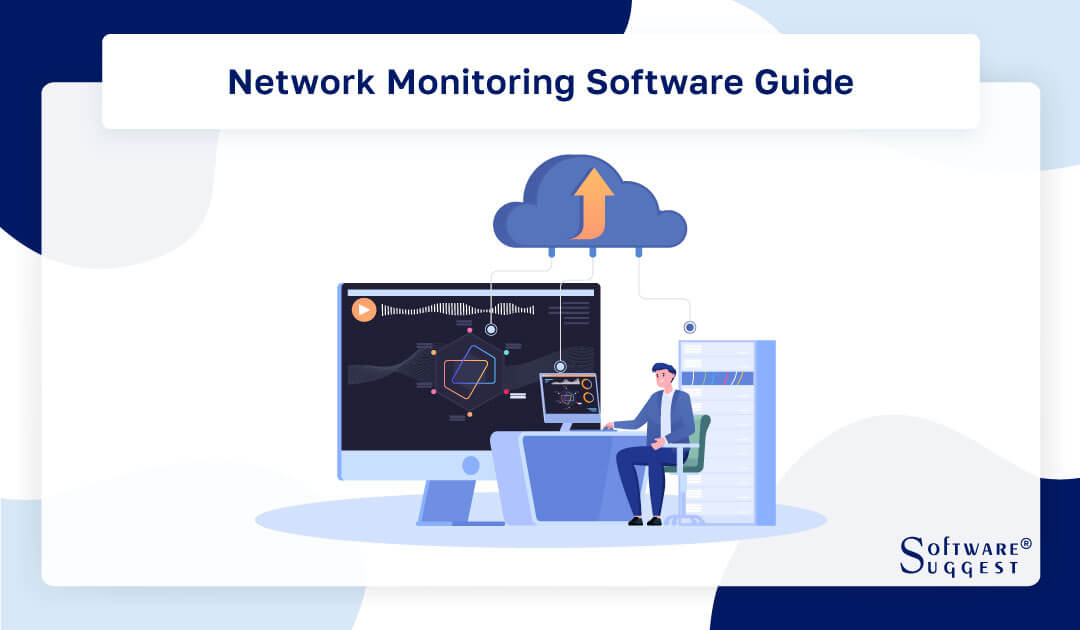
In today's digital world, having a reliable and effective network is crucial for ensuring that your organization runs smoothly. But how do you monitor and maintain your network to make sure it's working at peak efficiency? That's where network monitoring software comes in.
Making the ideal choice for your company's needs can be overwhelming with so many options available. To assist you in understanding the essential features and things to take into account while choosing the best network monitoring tools, we have produced this guide. We have the tools you need, whether you're searching for a straightforward tool for fundamental network monitoring or a more advanced solution for intricate IT infrastructures.
You will have access to the knowledge required to make an informed decision thanks to our in-depth reviews and professional analyses. Let's learn about the top network monitoring solutions for your company now.
What is Network Monitoring Software?
Network monitoring software is a vital tool that provides organizations with the ability to oversee and manage their networks effectively. The best network monitoring tools continuously monitor network performance, spotting potential problems and guaranteeing efficient use. It keeps an eye on a number of things, including bandwidth usage, device connectivity, and security risks.
Network managers can quickly address issues and avoid downtime with the help of real-time alerts and notifications. Network device monitoring tool makes proactive management possible, maximizing network effectiveness and raising total productivity. It enables organizations to make well-informed decisions and maintain a dependable and secure network infrastructure by offering insights into network health, traffic patterns, and resource consumption.
How Do Network Monitoring Tools Work?
Network monitoring tools for Windows play a significant role in streamlining the smooth operation of an establishment's network infrastructure. Network monitoring programs make use of various functions and methodologies to track network performance, find problems, and offer insightful information. Let's learn how the best network monitoring software work -
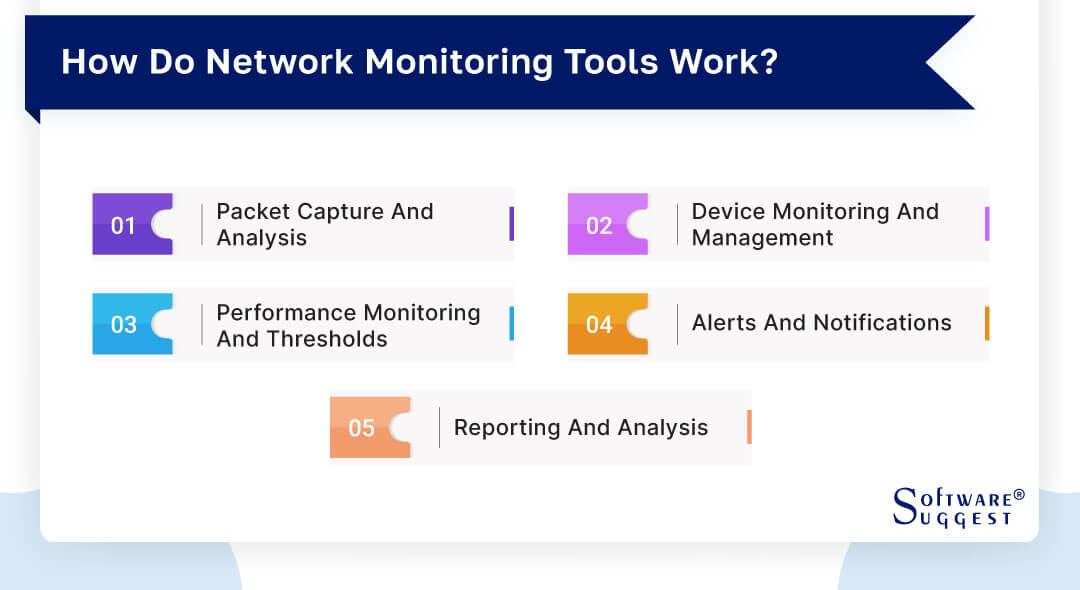
-
Packet capture and analysis
One of the fundamental techniques employed by network monitoring tools is packet capture and analysis. With the interception of data packets traveling via the network, NMS tools record network activity. They look into the headers and payloads of the packets and extract important data, including protocols, source and destination IP addresses, and application-level data.
-
Device monitoring and management
Network monitoring companies also focus on monitoring and managing network devices such as routers, switches, firewalls, and servers. These best network monitoring software utilize protocols such as SNMP to amass data from network devices. They amass details about the condition of the device, the usage of the bandwidth, the utilization of the CPU and memory, and other essential measurements. With the monitoring of the device, network administrators can monitor the general condition and performance of network components.
-
Performance monitoring and thresholds
In order to ensure that the network is performing at its best, the best network management software establishes performance baselines and thresholds. Administrators set thresholds for various metrics like bandwidth usage, latency, packet loss, and response times. When these metrics exceed the predefined thresholds, the tool triggers alerts and notifications, signaling potential issues that require attention. Performance monitoring allows administrators to address network problems before they escalate into major disruptions proactively.
-
Alerts and notifications
Top network monitoring tools provide real-time alerts and notifications to keep administrators informed about critical events or issues. When certain conditions are met, such as a device going offline, a sudden spike in network traffic, or a security breach, the tool generates alerts through various channels like email, SMS, or push notifications. These alerts enable administrators to respond promptly to network incidents, minimizing downtime and mitigating potential risks.
-
Reporting and analysis
Enterprise network monitoring software often offers comprehensive reporting and analysis capabilities. Over time, they collect and save information, allowing administrators to generate performance reports, observe trends, and comprehend network behavior.
The valuable information in these reports consists of specifics on network usage, application effectiveness, security vulnerabilities, and other crucial indicators. Reporting and analysis give administrators the ability to boost security precautions, optimize network performance, and match the network architecture to organizational needs.
Who Uses Network Monitoring Software?
Network monitoring software is a versatile tool that is utilized by various individuals and groups within an organization. These professionals depend on these instruments to guarantee the seamless functioning of the establishment's network structure. Here are some key users of network monitoring software:
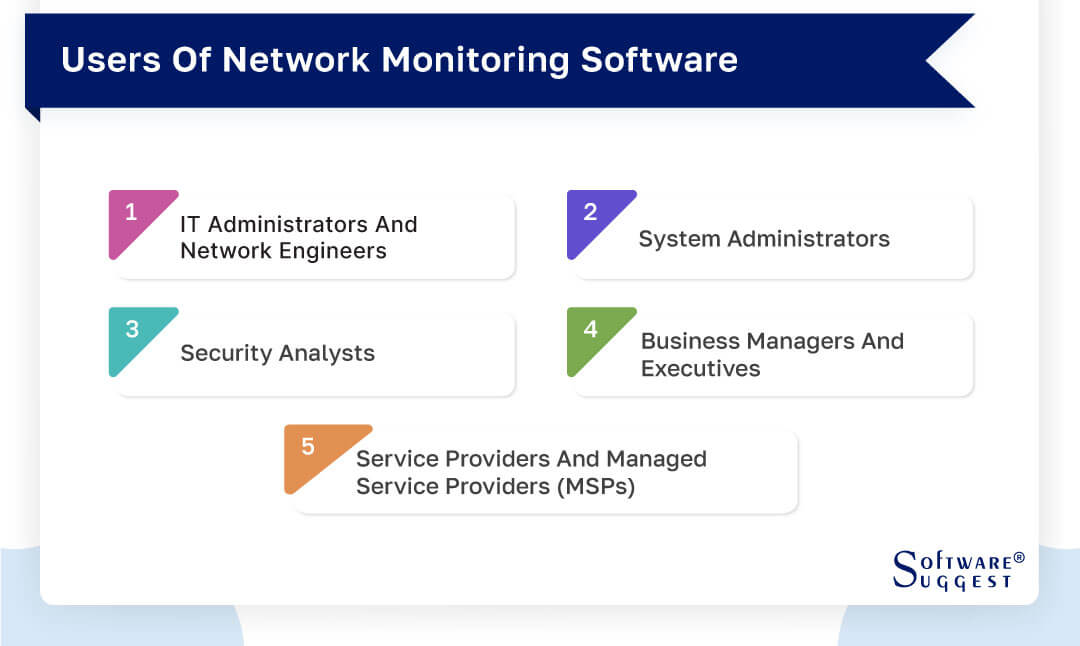
-
IT administrators and network engineers
IT administrators and network engineers are the primary users of network monitoring software. These professionals depend on these instruments to guarantee the seamless functioning of the establishment's network structure. Server network monitoring software offers them immediate insight into network efficiency, enabling them to recognize and solve problems promptly. IT managers and network engineers employ network surveillance software to oversee devices, monitor bandwidth usage, study traffic trends, and identify security risks.
-
System administrators
System administrators play a crucial role in maintaining the health and security of an organization's servers and systems. To check resource utilization, monitor server performance, and find any bottlenecks or vulnerabilities, they use the best home network monitoring software. Critical server metrics, including CPU and memory consumption, disk space, and application response times, are tracked by system administrators. They may quickly identify problems thanks to this proactive monitoring and stop system failures.
-
Security analysts
In today's digital landscape, maintaining robust network security is of utmost importance. Security analysts use the best network monitoring system to monitor network traffic and detect and investigate security incidents. Additionally, put in place strategies to protect the network. Popular network monitoring tools empower security experts to detect questionable patterns or irregularities in network data, suggesting possible online dangers.
-
Business managers and executives
Business managers and executives rely on mobile network monitoring tools for strategic decision-making even though they are not directly involved in the technical components. These experts evaluate network performance, make plans for future expansion, and effectively manage resources by using the insights and data produced by network monitoring software. Network monitoring software can be used by business managers and executives to assess how network faults would affect overall business operations.
-
Service providers and managed service providers (MSPs)
Service providers, including internet service providers (ISPs) and managed service providers (MSPs), heavily rely on network monitoring software to deliver reliable services to their clients. These providers utilize the software to monitor their network infrastructure, track performance, and ensure service level agreements (SLAs) are met. Network monitoring software allows service providers to proactively identify network issues, troubleshoot customer connectivity problems, and optimize network resources.
Benefits of Best Network Monitoring Tools
Network monitoring tools offer numerous advantages for organizations in managing and optimizing their network infrastructure. These tools empower administrators to optimize network performance, ensure reliable operations, and proactively address network issues. Hence, contributing to the overall success of the organization. Here are 8 key benefits of using network monitoring tools:
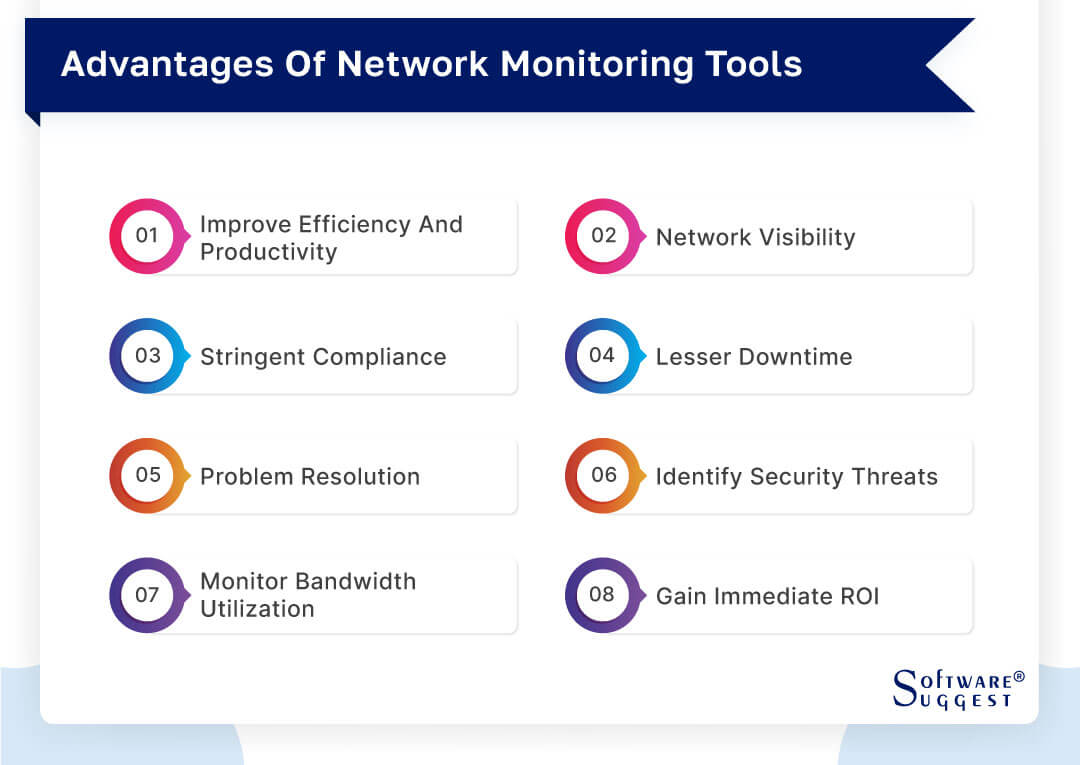
-
Improve efficiency and productivity
Tools for network monitoring can increase production and efficiency inside a company. Administrators can quickly identify and fix problems by having real-time visibility into network performance, minimizing downtime, and optimizing resource allocation. Administrators can use these tools to keep an eye on device performance, bandwidth usage, and network traffic.
-
Network visibility
Enhanced network visibility is a primary benefit of network monitoring tools. These technologies give network administrators in-depth knowledge of network behavior, including traffic patterns and performance indicators. Administrators can effectively track network usage, spot patterns, and make choices based on current facts by collecting and analyzing network data. Having better visibility allows administrators to spot unusual network behavior, foresee capacity needs, and proactively handle possible issues before they become serious concerns.
-
Stringent compliance
In regulated industries, network monitoring tools play a crucial role in maintaining compliance with industry standards and regulations. These tools monitor network activity, detect security incidents, and generate reports to demonstrate adherence to compliance requirements. Network monitoring tools provide the necessary data and audit trails to meet compliance standards. These include the Payment Card Industry Data Security Standard (PCI DSS), Health Insurance Portability and Accountability Act (HIPAA), or General Data Protection Regulation (GDPR).
-
Lesser downtime
Network downtime poses significant risks to organizations, leading to detrimental effects such as reduced productivity, financial losses, and damaged customer trust. However, network monitoring tools play a crucial role in preventing downtime by proactively identifying and addressing potential issues before they impact the network. By continuously monitoring network devices, servers, and applications, these tools keep a vigilant eye on performance metrics. They actively track parameters like response times, latency, bandwidth utilization, and device health.
-
Problem resolution
Network monitoring tools facilitate the rapid identification and resolution of network problems. With real-time alerts and notifications, these tools promptly notify administrators of potential issues that demand attention. When network performance metrics surpass predefined thresholds, such as high bandwidth utilization, increased latency, or excessive packet loss, network monitoring tools generate alerts. Administrators can then investigate the underlying causes and implement necessary measures to address the problems promptly.
-
Identify security threats
Tools for network monitoring are essential for spotting and preventing security risks. They keep an eye on network traffic and network protocols and study patterns to spot nefarious or suspicious activity. These technologies enable administrators to stay one step ahead of potential cyber dangers by spotting unauthorized access attempts, malware infestations, or data exfiltration. Network logs, firewall activity, and intrusion detection system monitoring allow managers to quickly spot security lapses and take the necessary corrective action.
-
Monitor bandwidth utilization
Efficient bandwidth management is vital for optimizing network performance and delivering a consistent user experience. Network monitoring tools play a crucial role in providing valuable insights into bandwidth utilization, empowering administrators to allocate network resources effectively and prevent congestion. By analyzing the data provided by network monitoring tools, administrators gain a deeper understanding of bandwidth utilization trends, allowing them to make informed decisions for capacity planning.
-
Gain immediate ROI
Investing in network monitoring tools yields an immediate return on investment (ROI). By proactively monitoring network performance and swiftly detecting issues, organizations can save costs associated with network downtime, inefficient resource allocation, and reactive troubleshooting. Network monitoring tools empower administrators to optimize network resources, identify underutilized assets, and strategically plan for future growth.
Features of Network Monitoring Software
The most crucial features of free network monitoring software will be covered in this section. Regardless of the size of your company or the number of employees it employs, knowing these factors can help you choose the right equipment to make sure your network is functioning properly. Here are the top 8 characteristics of the same -
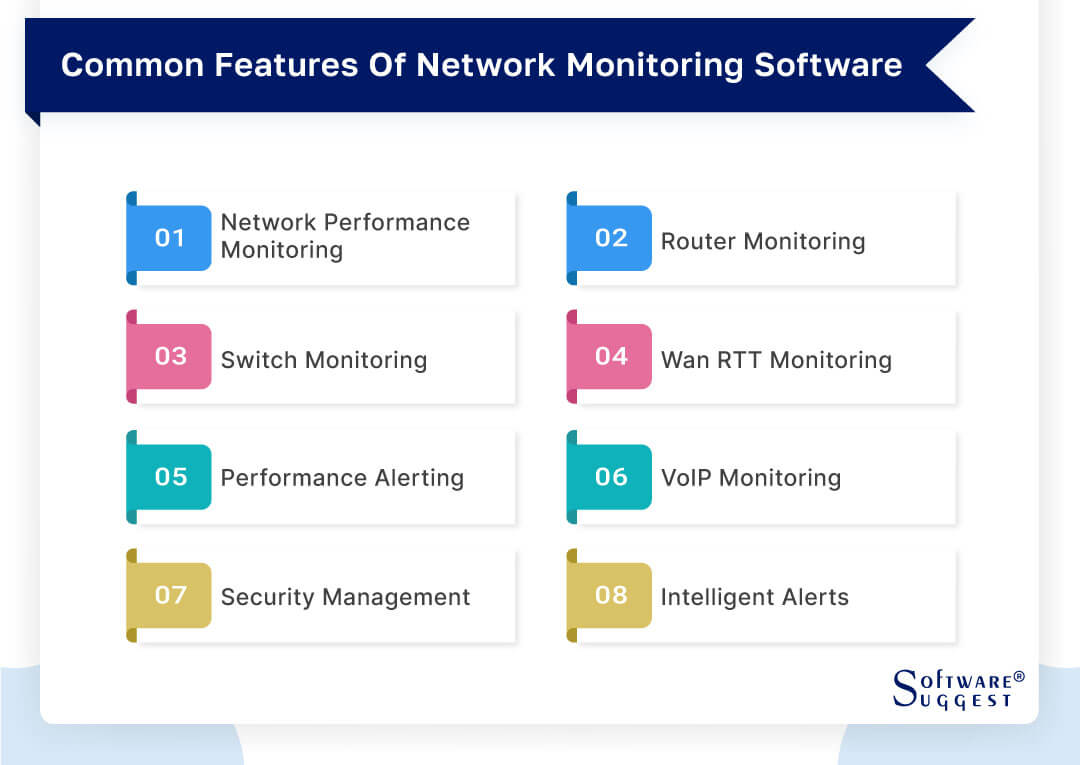
-
Network performance monitoring
Network performance monitoring is an essential aspect of network monitoring software. It enables administrators the ability to monitor and examine different performance parameters. Thus, assuring the best possible network performance. Administrators may learn a lot about the effectiveness of a network and spot possible problems. They can do this by continuously monitoring metrics like bandwidth utilization, latency, packet loss, and response times.
-
Router monitoring
Router monitoring is a critical aspect of network monitoring software, providing administrators with insights into the health and performance of routers in their network infrastructure. This feature allows administrators to monitor essential router metrics, including CPU and memory utilization, interface status, and routing protocols. By closely monitoring routers, administrators can swiftly identify potential issues such as high resource usage or connectivity problems.
-
Switch monitoring
Switch monitoring is a vital capability offered by network monitoring software, empowering administrators to effectively monitor and manage network switches. This function offers managers vital information on VLAN settings, network traffic patterns, and switch port usage. Administrators can quickly identify numerous things by monitoring switches.
To ensure effective operations, it addresses performance bottlenecks, resolves connectivity problems, and boosts switch performance. In order to keep the network infrastructure in good general shape and reliable, switch monitoring is essential.
-
WAN RTT monitoring
WAN RTT (Round Trip Time) monitoring is a valuable feature for organizations with distributed networks or multiple locations. This feature allows administrators to monitor the latency and response times between different sites or branches. By continuously monitoring WAN RTT, administrators can gain insights into network performance across geographically dispersed locations. They can identify potential latency issues, assess the quality of network connections, and ensure smooth communication and data transfer between different network segments.
-
Performance alerting
Performance alerting is a crucial feature that provides administrators with real-time notifications when network performance deviates from predefined thresholds. Administrators can set up alerts for various performance metrics such as bandwidth utilization, latency, or packet loss. When these metrics exceed or fall below the specified thresholds, administrators receive immediate alerts. Performance alerting empowers administrators to quickly identify and resolve network issues, reducing downtime and ensuring optimal network performance.
-
VoIP monitoring
VoIP monitoring is a specialized feature that focuses on guaranteeing the quality and reliability of Voice over IP (VoIP) calls. With this capability, administrators can closely monitor essential metrics like jitter, packet loss, and call quality. By actively monitoring VoIP performance, administrators gain the ability to proactively identify and address issues that may impact call quality and the overall user experience.
-
Security management
Security management is a pivotal and indispensable feature offered by network monitoring software. It equips administrators with the ability to effectively monitor and manage network security devices and processes.
Through this feature, administrators can diligently monitor network traffic patterns, meticulously analyze anomalies, and swiftly identify potential security breaches. By proactively monitoring network security, administrators can safeguard the network from unauthorized access, malware infections, and data breaches.
-
Intelligent Alerts
Intelligent alerts, an advanced feature of network monitoring software, utilize sophisticated algorithms to analyze network data and generate actionable alerts. These alerts are tailored to provide administrators with relevant information and prioritize critical issues. Unlike flooding administrators with a deluge of alerts, intelligent alerts deliver concise and meaningful notifications. With intelligent alerts, administrators can swiftly identify the most significant network problems and take prompt actions to address them.
How to Choose the Best Network Monitoring Tool?
Your organization's network performance and entire IT infrastructure might be significantly impacted by your decision regarding the finest network monitoring tools. With so many options on the market, it's important to take several things into account to make sure you choose the correct equipment. When selecting network monitoring tools, keep the following five factors in mind -

-
Scope of the system
Consider the scope of the system and ensure it aligns with your organization's specific needs. Ascertain whether you need monitoring for a dispersed network with numerous sites, a huge corporation, or a small office network. Examine the system's capacity to keep track of various network elements, such as servers, routers, switches, applications, and security hardware. Select a solution that can scale to fit the size and complexity of your network while providing comprehensive coverage.
-
Automated discovery of components
Efficiency is crucial when it comes to network monitoring. To quickly find and add network components to the monitoring system, look for tools that have automated discovery capabilities. Automated discovery ensures that all devices and apps are consistently monitored and does away with the need for human configuration. By reducing setup and configuration time and errors, this feature frees up administrators' time so they can concentrate on network analysis and management.
-
Scalability
Consider the scalability of the network monitoring tools to accommodate your organization's future growth. Make sure that the tools are capable of managing growing network traffic, extra devices, and expanding infrastructure. Tools that can scale allow you to incorporate new devices smoothly without impacting performance or needing significant upgrades. This adaptability guarantees that your network monitoring solution can adjust to your changing requirements and offer dependable monitoring as your network grows.
-
Clearly defined service level agreements (SLA)
Evaluate the vendor's service level agreements (SLA) to understand the level of support and response time you can expect. Look for clear and well-defined SLAs that outline the vendor's commitment to addressing issues and providing timely support.
Assess factors such as guaranteed uptime, response times for resolving critical issues, and availability of technical support. A robust SLA ensures that you receive the necessary assistance and support when you encounter network problems, minimizing the impact on your operations.
-
After-hours support model
Consider the availability of after-hours support when selecting network monitoring tools. Network issues can occur at any time, and having access to support during off-hours is crucial for maintaining uninterrupted network performance.
Ensure the vendor provides a suitable after-hours support model that aligns with your organization's needs. Whether it's 24/7 support, on-call technicians, or a dedicated support team, having reliable after-hours support ensures timely assistance and quick resolution of network problems, regardless of the time of day.
Top 5 Network Monitoring Software Comparison
|
Name
|
Free Trial
|
Demo
|
Pricing
|
|---|---|---|---|
|
30 Days |
Yes |
Custom pricing |
|
|
30 Days |
Yes |
Custom pricing |
|
|
14 Days |
Yes |
$149/month |
|
|
7 Days |
Yes |
Custom pricing |
|
|
30 Days |
Yes |
$1,899/license |
In the current digital era, network monitoring tools and software are crucial parts of keeping any computer network safe and secure. Choosing the best solution for your organization's needs might be challenging, given the wide range of options available. Five of the best network monitoring tools will be compared and contrasted in this section.
1. SolarWinds
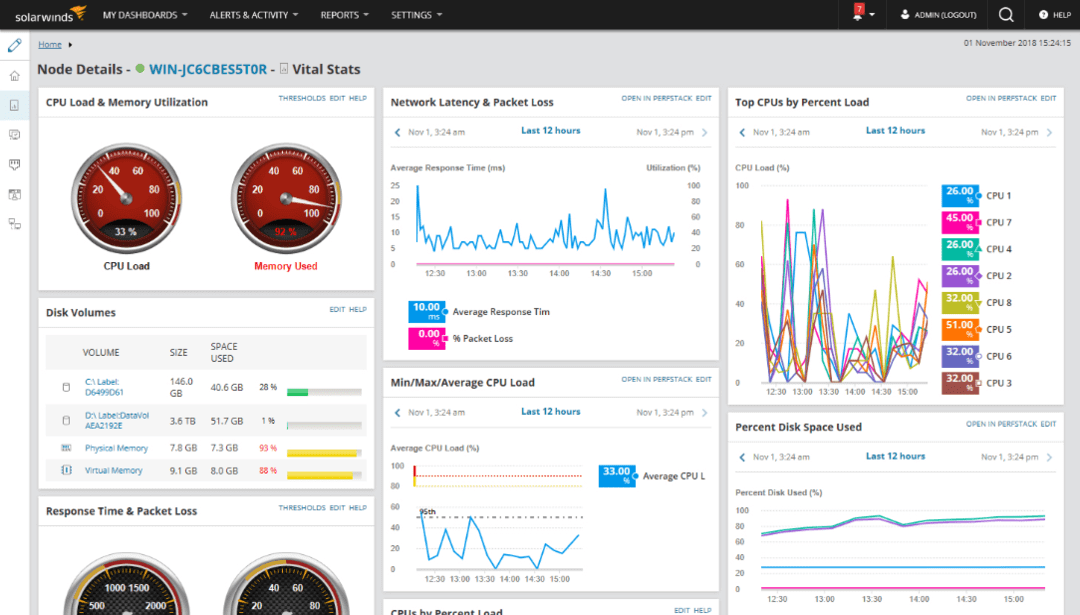
SolarWinds is a leading provider of IT infrastructure management software. Their remedies are created to assist IT experts in overseeing networks, servers, software, and storage effortlessly. SolarWinds offers customers a complete range of offerings that can be tailored to suit their particular requirements. Their objective is to simplify the lives of IT engineers while enhancing productivity and boosting effectiveness.
- Database performance analyzer
- Hybrid cloud observability
- Network bandwidth analyzer pack
- Network configuration manager
- Server & application monitor
- Service desk
- SolarWinds provides a diverse selection of customizable IT management software and tools to fulfill specific business requirements
- The company's software is user-friendly, with an intuitive and responsive interface that is effortless to navigate
- SolarWinds solutions are cloud-based, offering scalable and dependable services that are simple to uphold
- The company offers 24/7 customer support, guaranteeing prompt resolution of any problem
- Certain users have stated that SolarWinds software can be expensive, especially for small businesses with restricted budgets
- Certain users have encountered challenges with the integration between SolarWinds products and other external software
SolarWinds Pricing
- Custom pricing.
2. ManageEngine OpManager

ManageEngine Application Manager is a comprehensive application performance monitoring software. It is designed for IT teams who need to ensure the reliable performance of business-critical applications. This tool provides real-time insight into numerous applications' performance, enabling establishments to detect and solve performance issues promptly. The software is user-friendly, easy to implement, and provides an intuitive interface that IT teams can use effortlessly.
- OPM monitoring
- Monitor key metrics in real-time
- Track database statistics
- Keep tabs on configuration details
- Fix performance problems faster
- Applications Manager's OPM Monitoring tool offers comprehensive application performance monitoring
- Customizable alerts and performance thresholds allow quick response to potential problems
- Real-time analytics, customizable dashboards, and reports enable quick understanding of application performance and issue identification.
- The tool has a user-friendly interface for easy setup and usage.
- ManageEngine's Applications Manager OPM Monitoring tool is robust but comes with a cost
- Setting up the tool may require technical expertise, making it challenging non-IT professionals to manage and utilize
ManageEngine OpManager Pricing
- Custom pricing.
3. Atera
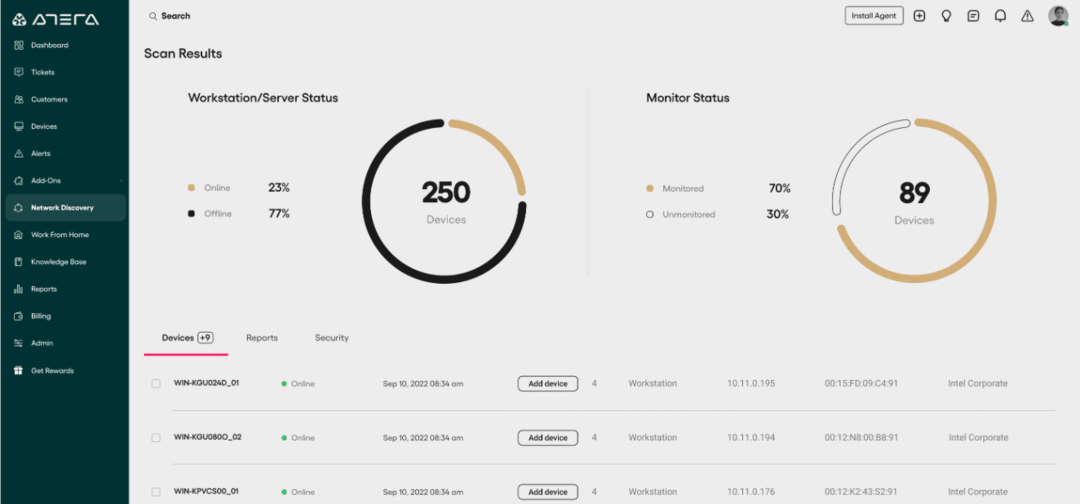
Atera is a cloud-based IT management software designed to meet the needs of small and medium-sized establishments. It provides a number of capabilities like reporting, helpdesk ticketing, and remote monitoring and management, making it a dependable and effective option for companies looking to simplify their IT operations. Atera is a well-liked option among IT professionals searching for a complete tool to manage their clients' networks and devices due to its user-friendly platform and inexpensive pricing.
- Remote monitoring and management
- Automated patching software
- AI-powered IT
- Security scan and 360° view
- Network discovery
- Atera provides a user-friendly interface that is simple to navigate and does not require any in-depth technical expertise
- Atera's pricing is competitive and flexible, allowing MSPs to choose a plan that suits their budget and business requirements
- The platform offers a complete suite of tools such as remote access, help desk, patch management, and inventory management, making it a true all-in-one solution
- Atera's reporting feature is customizable and provides detailed insights into assets and tickets to help with decision-making
- Compared to some of its rivals, Atera offers fewer integrations, which limits its functionality
- Atera's absence of a mobile application means it is not very convenient for MSPs who need to manage their business on the go
Atera Pricing
- Professional- $149 per month
- Master- $169 per month
- Enterprise- $199 per month
4. NinjaOne

NinjaOne is a cloud-based remote monitoring and management (RMM) software that allows MSPs and IT departments to automate, manage and remediate all endpoint management tasks within one platform. It offers a range of features, including patching, HIPAA compliance, and 24/7 support, making it a popular choice among IT professionals looking to streamline their operations.
- Endpoint management
- Patch management
- Simple network management protocol
- 1-click control for remote support
- Backup for distributed endpoints
- Automate IT management and drive technician efficiency
- Connects to devices using TeamViewer, whether they are connected to the internal network or the internet
- Access as a user or administrator to the command or powershell shell
- List all of the installed software for ease of use
- Even the HKCU registry entry is accessible
- Layering policies restrict end devices to only one policy
- Alerting system may need fine-tuning as it often generates excessive alerts
NinjaOne Pricing
- Custom pricing.
5. PRTG network monitor

PRTG Network Monitor is a comprehensive network monitoring software by Paessler. It supports establishments in ensuring the smooth and dependable operation of their IT infrastructure. PRTG provides a comprehensive solution for network monitoring, management, and troubleshooting with its user-friendly interface, customizable alerts, and strong data analysis capabilities.
- Distributed monitoring
- Integrated technologies
- Automatic network discovery
- Maps & dashboards
- Highly customizable reporting
- PRTG Network Monitor is a comprehensive network monitoring tool with a wide range of features
- The software is easy to set up and use, and it provides detailed insights into network performance, availability, and health
- PRTG Network Monitor can be configured to send alerts when issues arise
- The tool supports a variety of protocols, making it flexible and suitable for use in a wide range of network environments
- The cost of PRTG Network Monitor may be prohibitive for smaller organizations or businesses with limited IT budgets
- The software may be overwhelming for novice users, and it requires some technical expertise to set up and configure
PRTG Network Monitor Pricing
- Starting from $ 1,899 per license
Software and Services Related to Network Monitoring Software
When it comes to effectively managing and enhancing network performance, network monitoring software assumes a crucial role. Two significant components in this context are Application Performance Monitoring (APM) software and Network Management Software.
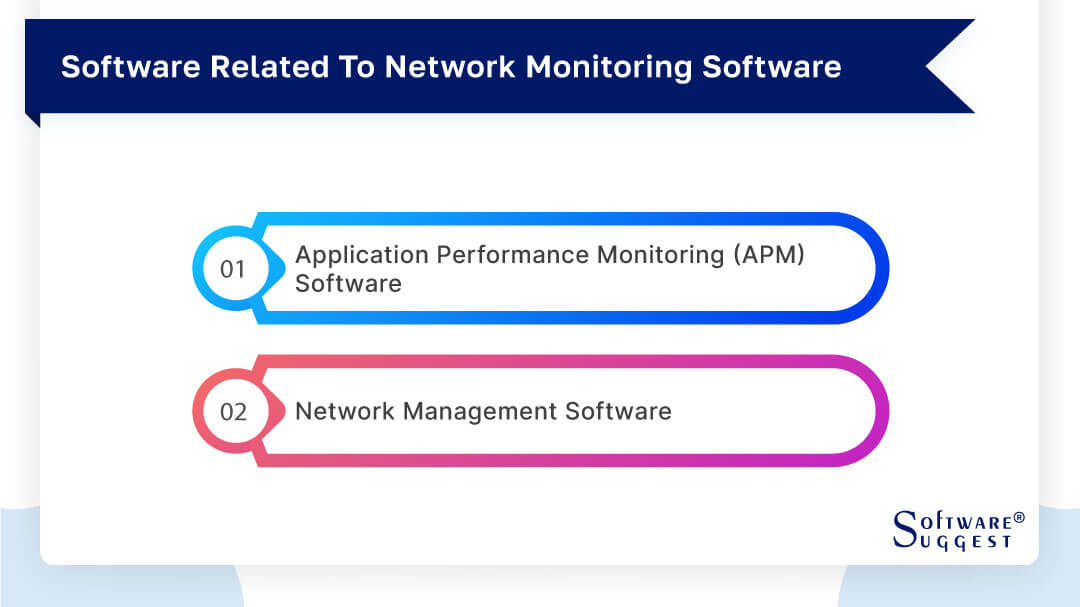
-
Application performance monitoring (APM) Software
APM software focuses on monitoring and optimizing the performance of specific applications running on a network. It reveals performance insights, points out bottlenecks, and aids administrators in comprehending the end-user experience. Key parameters, including response times, transaction volumes, resource utilization, and error rates, are tracked by APM software. Administrators can monitor application performance and take proactive measures to address problems to offer the best possible user experience by watching these data.
-
Network Management Software
Network management software offers a broader perspective on network operations and provides a centralized platform for monitoring and managing the entire network infrastructure. It includes a number of functionalities, such as device administration, network configuration, performance monitoring, traffic analysis, and security management.
Administrators can monitor network devices, monitor performance indicators, configure devices, identify and fix network problems, and enforce security regulations due to network management software. Administrators may proactively spot possible issues, allocate resources wisely, and enhance network performance thanks to the full picture of the network.
Potential Challenges Related to Network Monitoring Software
While network monitoring software is crucial for maintaining optimal network performance, there are potential challenges that organizations may encounter. Here are some common issues to consider:
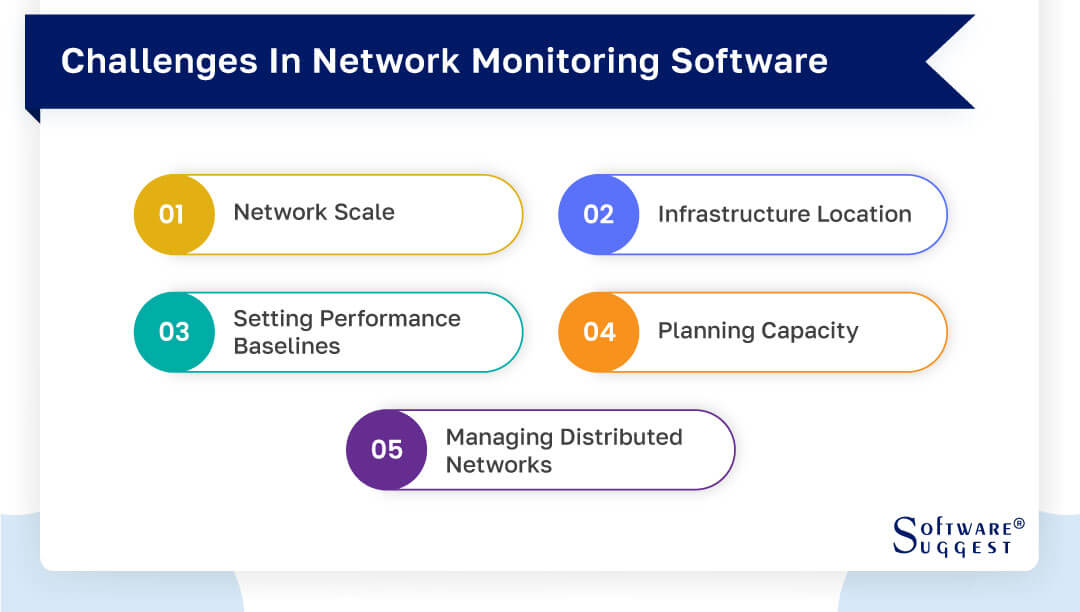
-
Network scale
One challenge organizations face is scaling network monitoring software to accommodate large and complex networks. As the network grows in size, the volume of data generated increases exponentially. Ensuring that the monitoring software can handle the scale and efficiently process and analyze the vast amount of network data is essential.
-
Infrastructure location
Managing network monitoring software becomes more challenging when the network infrastructure is distributed across multiple locations. Remote sites or branch offices often have limited IT resources, making it difficult to maintain consistent monitoring and collect data for analysis. Organizations need to consider deploying monitoring solutions that can efficiently monitor and consolidate data from distributed networks, enabling centralized visibility and control.
-
Setting performance baselines
Determining appropriate performance baselines for network metrics can be complex. Organizations need to establish benchmarks for network performance indicators such as bandwidth utilization, latency, and packet loss. However, setting accurate baselines requires a comprehensive understanding of network behavior under different conditions.
-
Planning capacity
Network monitoring software must be able to forecast capacity requirements accurately. Organizations need to plan for future growth, anticipating increased network traffic, additional devices, and expanding infrastructure. Failure to plan for capacity can lead to performance issues and the inability to monitor the network effectively. Network monitoring tools should offer capacity planning features to help administrators make informed decisions about resource allocation and network expansion.
-
Managing distributed networks
Managing network monitoring across geographically dispersed locations can be challenging. Distributed networks often have diverse network architectures and varying connectivity options. Administrators must ensure that the monitoring software can accommodate different network configurations and effectively collect data from remote sites. It is crucial to consider solutions that provide centralized management capabilities, allowing administrators to monitor and manage distributed networks from a single interface.
Latest Trends in Network Monitoring Tools
Network monitoring tools continue to evolve to address emerging trends and challenges in the networking landscape. Here are some of the latest trends shaping network monitoring tools:
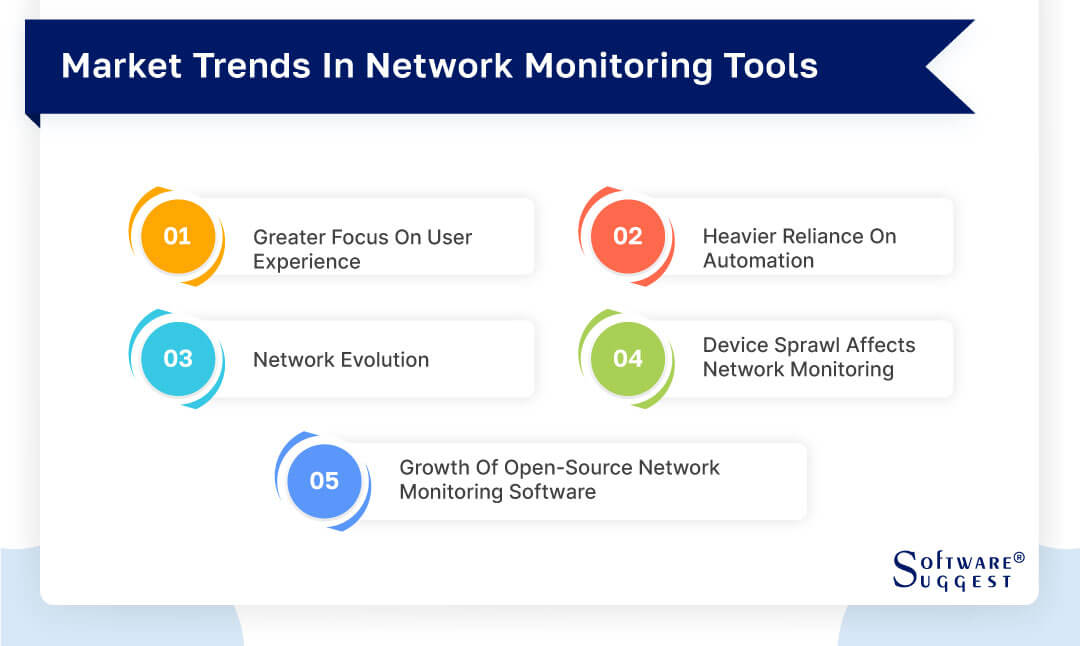
-
Greater focus on user experience
The user experience is becoming more important in modern network monitoring technologies. Administrators can simply access and comprehend network data thanks to user-friendly interfaces, smart dashboards, and configurable reports. Enhanced visualization features offer clear representations of network performance information, enabling administrators to spot problems quickly and decide with confidence.
-
Heavier reliance on automation
Automation is becoming increasingly prevalent in network monitoring tools. Automated discovery and device onboarding streamline the configuration process, reducing manual efforts and potential errors. Intelligent alerting and automated remediation workflows help administrators respond to issues promptly. By leveraging automation, organizations can enhance operational efficiency, reduce response times, and optimize network performance.
-
Network evolution
Network monitoring tools are adapting to the changing network landscape. It encompasses the implementation of technologies like cloud computing, software-based networking (SDN), and the Internet of Things (IoT). These solutions are created to oversee and analyze mixed and multi-cloud settings, virtualized networks, and varied network structures. They offer insight into these developing networks, guaranteeing thorough monitoring and control abilities.
-
Device sprawl affects network monitoring
The proliferation of devices in modern networks, including IoT devices and mobile endpoints, poses challenges for network monitoring. In order to ensure thorough visibility and security, network monitoring solutions must be able to identify and keep track of a variety of devices. Effective network monitoring requires solutions that support a variety of device kinds and have strong device profiling and management features.
-
Growth of open-source network monitoring software
Open-source network monitoring software is gaining popularity due to its flexibility, cost-effectiveness, and active community support. These tools offer organizations the freedom to customize and extend the functionality to meet their specific needs. Open-source solutions also benefit from the collective knowledge and contributions of the community, ensuring regular updates, bug fixes, and feature enhancements.
Conclusion
In conclusion, choosing the best network monitoring software for your establishment can be a complex process, but it is essential for maintaining the health, security, and efficiency of your network. You can choose the software alternative that best satisfies your objectives while staying within your budget by carefully examining your individual requirements. The top 5 network monitoring software that we have listed are well-researched and can be your next purchase.
FAQs
The cost of network monitoring software range from $200 to several thousand dollars depending on the vendor size and complexity of the network, as well as the features offered by the software.
The cost of network monitoring software varies depending on the size and complexity of the network, as well as the features offered by the software.
The four categories of network monitoring are availability monitoring, performance monitoring, security monitoring, and configuration monitoring.
By Countries























